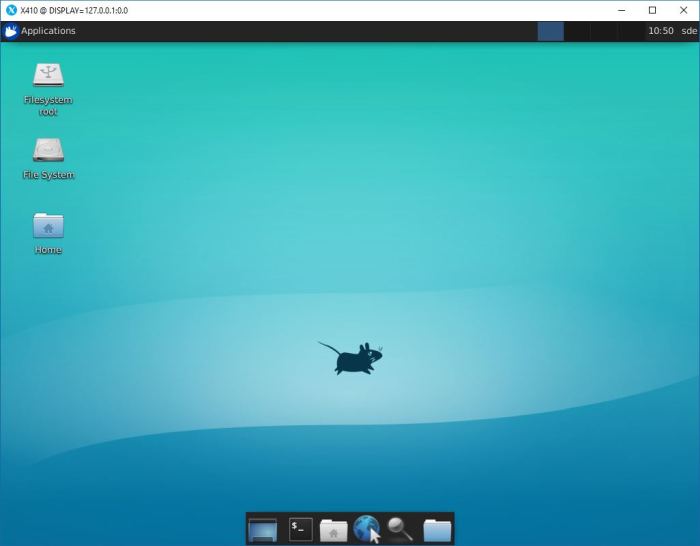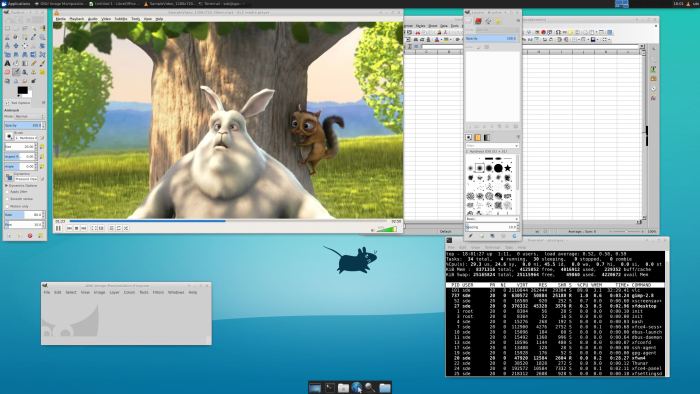Last Updated on January 1, 2021
In Operation
X410 offers a full desktop mode offering a complete X Window desktop experience using a traditional Linux desktop environment such as Xfce.
Alternatively, you can run windowed apps, so your Linux GUI apps appear side-by-side with their Windows counterparts. In the windowed mode, X410 uses its own window manager for Linux GUI apps that enables you to position and resize the apps along with Windows apps.
And there’s a floating desktop option whereby X410 is shown as a resizable blank window, with Linux GUI apps displayed and confined to that window. Like the full desktop mode, you can run a Linux desktop environment.
Fonts are beautifully rendered in all modes.
The image below shows X410 in the floating desktop mode. If you’re familiar with Linux desktops, you’ll realize that the system is running the lightweight Xfce desktop environment. And it’s incredibly fast for the desktop to start taking less than three seconds.

The image below shows X410 running in full desktop mode. Again the desktop environment is Xfce. This time, the software is playing a 1280×720 video with VLC media player. We’ve also started GIMP, a terminal, and LibreOffice Calc. Of course, these applications are available natively for Windows. But there are tons (and I mean literally tons) of Linux GUI apps that haven’t been ported over to Windows, and probably never will be. Even when native Windows ports are available, they often languish behind their Linux counterpart.

Performance
When it comes to performance, WSL with any X server is never going to offer native Linux X11 server speed. However, X410 with WSL offers extremely good performance, particularly if you’re not running 4K resolution. Both latency and rendering are very good. Desktop mode in X410 uses Direct3D.
Bear in mind that using X410 with WSL will consume more CPU cycles, particularly with graphically intensive software (even if that software makes little/no use of hardware acceleration). But memory usage is very low. For example, when X410 is launched in ‘Windowed Apps’ mode it only consumes about 10MB of RAM.
As an indication of the rendering, our experience is that video playback is flawless provided you don’t try to run the video full screen in a very high resolution.
We’ve tried a number of other X servers with WSL. X410’s performance far exceeds MobaXTerm, VcXsrc, or Xming. Of these, only VcXsrc is open source software.
Sound
WSL doesn’t currently support sound devices. Hence when you open a GUI desktop or apps in X410, you will only hear basic system bells. But, as explained in our installation section, you can use PulseAudio to get sound up and running. PulseAudio is a sound system which has been ported to Windows, although only a preview binary is available.
When playing videos, audio playback was good but not perfect with some occasionally glitches particularly when the system was under any intensive activity.
No hardware acceleration
One thing to bear in mind is that neither WSL nor X410 offer hardware acceleration. Whereas when you run Linux natively, X.Org server does support 2D hardware acceleration. Hardware acceleration refers to tasks being offloaded from the CPU to other more appropriate devices/hardware.
Many desktop environments (and other applications) use hardware acceleration for their graphical interface. Running X410, you’ll therefore need to configure your desktop environment accordingly, or use a desktop environment that doesn’t rely on hardware acceleration. Otherwise interacting with the desktop feels like treacle.
If hardware acceleration is important to you, virtualization software like Oracle VM VirtualBox may be a better choice as that solution offers hardware acceleration for 3D graphics and 2D video for guest applications.
Next page: Page 4 – Other Features
Pages in this article:
Page 1 – Introduction
Page 2 – Installation and Configuration
Page 3 – In Operation
Page 4 – Other Features
Page 5 – Summary

but why would you pay for an operating system to be able to use a free one within… there is no point…. now the other way around LSW would actually make sense. Solid stable OS running the red headed stepchild of OS’s out there Windows.
There’s lots of point. For example, my work provides me with a Windows laptop. I didn’t pay for the Windows license. Running an X server lets me use my fav Linux apps on the Windows machine.
Exactly James, there must be billions with Windows machines, don’t want or can dual boot, don’t want to wipe Windows or use virtualization software, yet still want to try something different (and better).